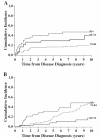Effect of age and comorbidity on the treatment and survival of older patients with vulvar cancer
- PMID: 21402401
- PMCID: PMC4589275
- DOI: 10.1016/j.ygyno.2011.02.005
Effect of age and comorbidity on the treatment and survival of older patients with vulvar cancer
Abstract
Objective: To determine the disease characteristics and comorbidities predictive of vulvar cancer specific mortality and five year overall survival among older women, ages 65 and above.
Methods: A retrospective analysis was conducted of women diagnosed with vulvar cancer at a single regional cancer center from 1989 to 2003, with a follow up to 2009. Treatment records were extracted for: demographics and treatment information, Eastern Cooperative Oncology Group (ECOG) performance status and Charlson comorbidity index score. Probability of death from vulvar cancer was estimated using cumulative incidence, treating death by other known and unknown causes as competing risks. Predictors of overall survival were determined using multivariate Cox regression analyses.
Results: One hundred forty-six women were identified, with a median age at diagnosis of 79 years (range 65-95). Median follow up was 5.0 years (range 0.1-16.7 years). The cumulative incidence of vulvar cancer-specific mortality was 13% (95% CI: 0.08-0.19) at year one, 24% (95% CI: 0.17-0.31) at year three and 26% (95% CI: 0.19-0.33) at year five. Use of adjuvant therapy or surgical procedure performed did not differ by age at diagnosis (p=0.807 and 0.663) according to age group (65-74, 74-84 and 85+). Increasing age, Charlson comorbidity index score, lymph node involvement and type of surgery performed were associated with increased risk of death from any cause (all p<0.05).
Conclusion: Among women aged ≥65, vulvar cancer specific mortality was most significant in the first three years after diagnosis. Conversely other causes of mortality which can be attributed to comorbid conditions steadily increased with time.
Copyright © 2010. Published by Elsevier Inc.
Figures
Similar articles
-
Investigation of clinicopathological features of vulvar cancer in 1068 patients: A Japanese Gynecologic Oncology Group (JGOG) nationwide survey study.Gynecol Oncol. 2020 Nov;159(2):449-455. doi: 10.1016/j.ygyno.2020.08.019. Epub 2020 Aug 25. Gynecol Oncol. 2020. PMID: 32854973
-
Management and outcomes for elderly women with vulvar cancer over time.BJOG. 2014 May;121(6):719-27; discussion 727. doi: 10.1111/1471-0528.12580. Epub 2014 Feb 24. BJOG. 2014. PMID: 24621118
-
Vulvar carcinoma in Norway: A 50-year perspective on trends in incidence, treatment and survival.Gynecol Oncol. 2017 Jun;145(3):543-548. doi: 10.1016/j.ygyno.2017.03.008. Epub 2017 Mar 27. Gynecol Oncol. 2017. PMID: 28356187
-
Vulvar squamous cell carcinoma: guidelines for early diagnosis and treatment.Am J Obstet Gynecol. 2003 Sep;189(3 Suppl):S17-23. doi: 10.1067/s0002-9378(03)00792-0. Am J Obstet Gynecol. 2003. PMID: 14532899 Review.
-
FIGO stage, histology, histologic grade, age and race as prognostic factors in determining survival for cancers of the female gynecological system: an analysis of 1973-87 SEER cases of cancers of the endometrium, cervix, ovary, vulva, and vagina.Semin Surg Oncol. 1994 Jan-Feb;10(1):31-46. doi: 10.1002/ssu.2980100107. Semin Surg Oncol. 1994. PMID: 8115784 Review.
Cited by
-
Comparison of two types of the triple incision technique in the treatment of patients with locally advanced vulvar cancer.Int J Med Sci. 2020 Sep 16;17(16):2578-2584. doi: 10.7150/ijms.49804. eCollection 2020. Int J Med Sci. 2020. PMID: 33029100 Free PMC article.
-
The age-adjusted Charlson comorbidity index as a predictor of survival in surgically treated vulvar cancer patients.J Gynecol Oncol. 2019 Jan;30(1):e6. doi: 10.3802/jgo.2019.30.e6. Epub 2018 Oct 4. J Gynecol Oncol. 2019. PMID: 30479090 Free PMC article.
-
Relevance of computerized tomography in the preoperative evaluation of patients with vulvar cancer: a prospective study.Cancer Imaging. 2015 Jun 10;15(1):8. doi: 10.1186/s40644-015-0044-2. Cancer Imaging. 2015. PMID: 26059775 Free PMC article.
-
Comparison of cisplatin and mitomycin C/5-FU as radiosensitisers in the treatment of locally advanced vulvar cancer: results of a retrospective, observational, single-institutional cohort study.J Cancer Res Clin Oncol. 2023 Apr;149(4):1391-1399. doi: 10.1007/s00432-022-04006-0. Epub 2022 Apr 22. J Cancer Res Clin Oncol. 2023. PMID: 35451700 Free PMC article.
-
Comorbidity and cervical cancer survival of Indigenous and non-Indigenous Australian women: A semi-national registry-based cohort study (2003-2012).PLoS One. 2018 May 8;13(5):e0196764. doi: 10.1371/journal.pone.0196764. eCollection 2018. PLoS One. 2018. PMID: 29738533 Free PMC article.
References
-
- Saraiya M, Watson M, Wu X, King JB, Chen VW, Smith JS, et al. Incidence of in situ and invasive vulvar cancer in the US, 1998–2003. Cancer. 2008;113:2865–72. - PubMed
-
- Judson PL, Habermann EB, Baxter NN, Durham SB, Virnig BA. Trends in the incidence of invasive and in situ vulvar carcinoma. Obstet Gynecol. 2006;107:1018–22. - PubMed
-
- Arias E. National vital statistics reports. 21. Vol. 58. National Center for Health Statistics; Hyattsville, MD: 2010. United States life tables, 2006. - PubMed
-
- Homesley HD, Bundy BN, Sedlis A, Yordan E, Berek JS, Jahshan A, et al. Assessment of current International Federation of Gynecology and Obstetrics staging of vulvar carcinoma relative to prognostic factors for survival (a Gynecologic Oncology Group study) Am J Obstet Gynecol. 1991;164:997–1003. - PubMed
-
- Landrum LM, Lanneau GS, Skaggs VJ, Gould N, Walker JL, McMeekin DS, et al. Gynecologic Oncology Group risk groups for vulvar carcinoma: improvement in survival in the modern era. Gynecol Oncol. 2007;106:521–5. - PubMed
Publication types
MeSH terms
Grants and funding
LinkOut - more resources
Full Text Sources
Medical



